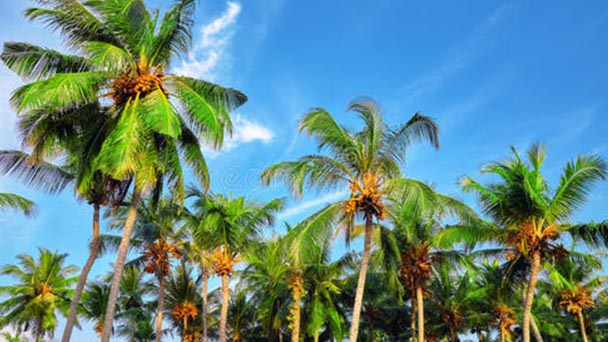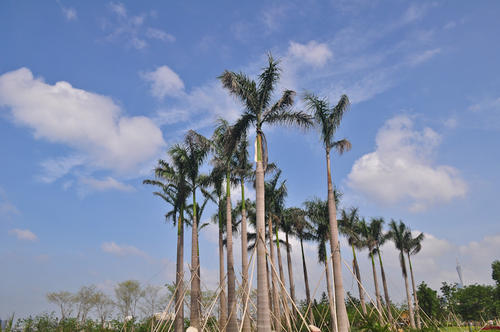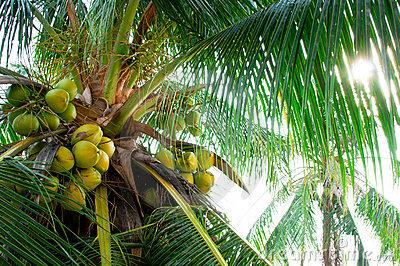Cocos nucifera profile
Written by Maggie
Dec 24 2020

Cocos nucifera is an evergreen tree belonging to the palm family coconuts, and its stem is thick and erect, up to 30m high. Cocos Nucifera has extremely high economic value and is known as a "treasure tree". Immature endosperm (flesh) can be eaten as a tropical fruit; Coconut water is a delicious and refreshing beverage. Besides drinking it, it is also a good promoter of tissue culture. Matured coconut meat contains up to 70% fat, can be pressed oil, but also can be processed into various candies, cakes. Coconut shells can be used for various utensils and crafts, as well as activated carbon. Coconut fibers can be made into brushes, carpets, cables, etc. The tree trunk can be used as building materials, the leaves can be roofed or woven, the roots can be used as medicine, because of the beautiful tree appearance, it is an important tree species in tropical areas to beautify and green the environment.
Cocos nucifera picture

Cocos nucifera morphological characteristics
Cocos Nucifera is mainly composed of green coconut, yellow coconut and red coconut. Cocos Nucifera is generally as high as over 25 meters, with straight trunk without branches or stems, and huge feather-like leaves stretching out from tree tops, supporting an umbrella like green leaf and feather-like whole split, 4-6 meters long, with many lobes, leathery, linear-lanceolate, 65-100 cm long and 3-4 cm wide apex acuminate. The petiole is stout, more than 1 m long. Inflorescences are axillary, 1.5-2 m long, much branched, male flowers clustered on upper branches, female flowers scattered on lower ones; Cocos Nucifera has 3 male flowers sepals, scaly, 3-4 mm long, petals 3, leathery, ovate-oblong, 1 -- 1.5 cm long; Cocos Nucifera has 6 Stamens; Female flowers are based with several bracteoles, sepals leathery, rounded, ca. 2.5 cm wide, petals similar to sepals, but smaller.N uts are ovate or subglobose, apex micro trigonal, 15-25 cm long, endocarp bony, 3 germination holes near base, 1 seed; The endosperm contains a succulent cavity. The ripe fruit is ovate or ellipsoidal, with a thick outer shell, rich in fiber; The endocarp is hard, endosperm filled (made of coconut meat and coconut water), embryo small.
Cocos Nucifera usually starts to bear fruit after 5-6 years, 15-18 years is the fertile period, 40-80 per plant, more than 100, the economic life is more than 80 years. The number of leaves produced by coconut trees varies with the age of the trees. The number of leaves produced by coconut trees tends to increase with the age of the trees before the fertile period and decrease slightly after the fertile period, but it can remain constant. About 3 leaves were taken in the average annual period of seedlings, and 10-13 sapling, 14-15 juvenile and 12-13 adult trees were not produced. As the plant aged, the number of leaves produced per year decreased correspondingly. Within a year, due to seasonal changes, the number of leaves per month also has a certain change. The number of buds of young fruited trees per year was less than that of adult trees, which was 10.6 on average and 12 on average. In a year, the number of bracts is the most from May to June, and the least from November to December. The inflorescence shows through 3.5 months after the bud is drawn, called flowering, flowering most in July-September, and the pistil most in the open bud, least from November to the next March. It takes 12 months from fertilization to fruit ripening.
Commercially grown coconuts, still green and immature at harvest time, are a little triangular in shape, the size of a football. The "coconut" sold in shops is actually the brown core of a coconut, also known as the "kernels". Outside this core there's actually a very thick fibrous crust and a green hard shell. To save space for transportation, the extraneous parts are usually removed before transportation. The pit contains about a liter of almost clear sweet juice and fragrant flesh.
Cocos nucifera growing environment
Cocos Nucifera is a tropical light-loving crop, which grows well under the conditions of high temperature, heavy rain, abundant sunshine and wind blowing. It is required that the annual average temperature should be above 24-25 degrees, the temperature difference is small, the whole year without frost, the coconut can blossom and bear fruit normally, and the optimal growth temperature should be 26-27 degrees.
Cocos Nucifera is suitable for low altitude areas, China's Hainan Island in the altitude of 150-200 meters below can grow well. It is required that the annual average temperature should be above 24-25℃, the temperature difference should be small, the whole year without frost, the coconut can blossom and bear fruit normally, and the optimal growth temperature should be 26-27℃. If the average temperature is 18℃ for one month in a year, the yield will decrease obviously. If the average temperature is lower than 15℃, it will cause falling flowers, falling fruits and leaves to turn yellow. The moisture condition should be more than 1500-2000 mm annual rainfall, and the distribution is uniform, but in the area with abundant underground water or irrigation, the annual rainfall of 600-800 mm can also grow well; Drought affects coconut yield for 2-3 years, and long-term water accumulation also affects Cocos nucifera growth and yield.
In terms of soil fertility, potassium is required. The pH value of the soil can be 5.2-8.3, but 7.0 is most suitable. Cocos Nucifera have strong wind resistance, with strong winds of class 6-7 having only a slight effect on their growth and yield. A typhoon of magnitude 8-9 can blow off a small number of leaves and tear the leaflets. Strong typhoons above 10-12 have serious harm to coconut. Conditions are right, and after two years of planting the Cocos Nucifera begins to bear fruit.

Cocos nucifera distribution range
Cocos nucifera is widely distributed in the tropical coastal and inland areas of Asia, Africa, Oceania and America. It is mainly distributed between 20° n and 20° N, especially in the equatorial coastal area. Secondly, it also has a large area distribution in the range of 20°-23.5° n. Cocos Nucifera are mainly distributed throughout Hainan Island in China, accounting for about 80% of the country's total area and output. In addition, small amounts are also cultivated in Xisha and Nansha Islands, Shangchuan and Xiachuan Islands in Guangdong, Tainan, Xishuangbanna in Yunnan, And Beihai and Qinzhou in Guangxi.
Cocos Nucifera is usually distributed in tropical or subtropical areas, such as Hainan province, Yunnan Province, Maldives and other regions. It is native to Malay Islands, and has been cultivated in Hainan Province of China for more than 2,000 years.
Cocos Nucifera main value
Coconuts belong to the genus of organic fruit, pollution-free, rich in Vitamin B, C, sodium, protein, amino acids and complex polysaccharide substances.Coconut juice can be drunk, can do drinks. Coconut water is rich in protein, fat and a variety of vitamins, which can promote the growth of cells, strengthen the stomach and drink, and sweeten the summer heat. (The Red Army of The Qiongya Column once injected coconut water into veins instead of glucose water to maintain life.) The flesh is white and can be eaten or pressed for oil, which is rich in nutrition. The peel fiber can be netted, the trunk can be used as building material, and the bark has medicinal value.

Latest Updated
- Benefits of Bugleweed - 7 Science-backed Health Benefits
- Bugleweed Dangers & Side Effects - Is It Poisonous?
- How to Plant Evergreen Trees - What You Should Know
- When to Plant Evergreens - Grow Guide for Evergreen Trees
- 12 Wonderful Evergreen Shrubs for Your Garden
- 12 Popular Evergreen Plants with Pictures for Beginners
- When And How To Prune A Lilac Bush Like a Pro
- How to Grow & Care for Lilac Vine (Hardenbergia Violacea)
- Japanese Lilac Tree (Syringa Reticulata) Care & Propagation Guide
- Shumard Oak Pros and Cons - What to Know
Popular Articles
- Winter maintenance of Antirrhinum Majus
- How to Grow Terminalia Mantaly Tree
- How to Grow and Care for Crossostephium Chinense
- How to grow Antirrhinum Majus in spring
- Peristeria Elata (Dove Orchid) Profile: Info & Care Guide
- Underwatered Snake Plant (Sansevieria Trifasciata) - Signs And How To Fix
- How to Care for Brazilian Jasmine Plant (Mandevilla Sanderi)
- How to Grow & Care for Graptopetalum Purple Delight in Summer
- Rosa Chinensis (China Rose): Plant Growing & Care Tips
- How to Care for Baby Sun Rose (Aptenia Cordifolia)